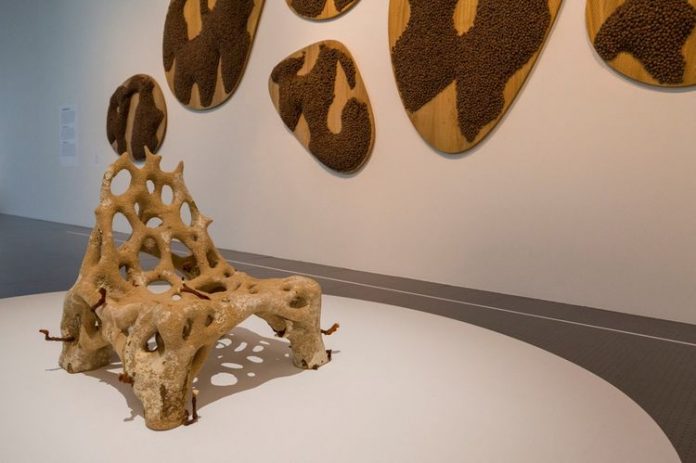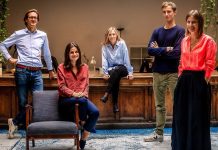Posted Oct 1, 2022, 1:00 PM
Who would have thought that the mushroom would become more than the star of the undergrowth? In medicine, energy, science, these organisms have applications in all areas that could well revolutionize our daily lives.
But the mycelium, the invisible part of the mushroom that develops underground, becomes the new challenge for designers: “It was my first experience of collaborating with the living”, confides Margaux Padrutt, designer winner of the Boisbuchet Residency Award 2021 for “Mush », a table lamp project based on oyster mushroom mycelium and sawdust that she created with interior architect and designer Marion Payet. “It brought me a lot in terms of design and creation to tell ourselves that our role was not necessarily to design everything from A to Z and try to control everything. Precisely, there was also a lot of potential in things that we didn’t suspect and that made me enthusiastic to work on this kind of land in harmony with the landscape and the territory”.
Accessible, malleable, biodegradable since it can return to nature, the mycelium remains a challenge for designers and architects who have to deal with this unique biomaterial. “The mycelium needs to develop, it’s something that takes time to achieve,” explains Margaux Padrutt, confiding in the obstacles she faced during the development of her project, the choice of good substrate for the mycelium to support some weight until working in a sterile space to prevent mold growth. But the young woman who is now working on her prototype with the Ecotopia organization in Marseille is certain: the mycelium object is developing. “We are producing more and more of them, even if we remain in an era of experimentation where we are not sure what works and what does not work”. In any case, here are six mycelium-based creations by designers who have taken the plunge.
Sneature, Emilie Burfeind’s sneakers with a mycelium sole
Created by designer Emilie Burfeind, the Sneature is a pair of sneakers unlike any other. Entirely biodegradable, it is its mycelium-based sole that interests us here, even if the rest of the shoe, designed with organic rubber and dog hair, is also worth a look. Thanks to its mycelium sole, the pair of sneakers can be, once it reaches the end of its life, dismantled into several parts and reused for other purposes. Although still only a study project carried out at the Offenbach University of Art and Design in Germany, this innovative alternative to polluting shoes paves the way for the integration of the fungus from head to toes.
Fashion Student winner Sneature by Emilie Burfeind is a biodegradable waste based footwear. It uses a 3D knitting technology to spin together dog hair and comes with with soles made from fungi. What a creative idea, isn’t? https://t.co/LmJZpfpAxL pic.twitter.com/9h5YfDk5f4
— Green Product Award (@GP_Award) September 28, 2021
The “Mycelium flesh” by Eric Klarenbeek and Maartje Dros
Thanks to 3D printing, the Dutch Eric Klarenbeek and Maarte Dros were able to develop a living chair. After making a mold in the shape of the desired object, the creators used different components, biomass and water, to grow the living organism until it took full possession from the mold and harden.
Exhibited at the Center Pompidou-Metz, the Mycélium chair is part of “Mimésis: un design vivant”, a collective exhibition on the evolution of nature in design which runs until February 6, 2023.
The “Mycélium chair” by the Dutch studio Klarenbeek & Dros during the exhibition “Mimesis – un design vivant” at the Center Pompidou Metz in June 2022.JEAN-CHRISTOPHE VERHAEGEN/AFP
MYX Lamp, the edible lampshade by Jonas Edvard
Created by Jonas Edvard, a designer specializing in biological materials such as algae or mushrooms, the “Myx Lamp” is the result of the fusion between mycelium and textile materials. First creation of a project that the designer began in 2012, this lamp, whose fluffy skin comes entirely from the growth of the living organism, is constantly evolving. After the three weeks of development required to create the lampshade, oyster mushrooms can appear on the prototype and be tasted. However, for these mushrooms to be healthy, the conditions must be perfect.
The MYX Lamp by Jonas EdvardDR
Sun Gate #2, the alliance of ancient knowledge and the environmental future
Sculpture inspired by a sundial that brings together an ancient Chinese culture and the prospect of an innovative future, “Sun Gate #2” is built from mycelium. Completely dehydrated, the mushroom in this form cannot continue to grow but gives a solid structure to this artistic creation.
The Sun Gate #2 based on myceliumNiko de LaFaye.
Hy-fi, the mycelium tower
Far from preconceived ideas, the use of the mycelium in the field of design and creation is not limited to all that is small. Created by David Benjamin, these 12-meter-tall towers, which required more than 10,000 bricks of corn stalk and mycelium, won the young architect and designer the MoMA PS1 award in 2014.
At the antipodes of the buildings of Queens, passers-by have nevertheless appropriated this ephemeral installation, which has become a space of respite from the bustle and tumult of New York. The installation and removal of this structure did not generate any CO2 emissions. Since this impressive demonstration of the interest of this part of the fungus as a natural glue, the mycelium has been studied in the context of the construction of habitable modules, particularly on Mars.
Hy-Fi in courtyard of MoMA, NYC pic.twitter.com/2bLtvslCW1
— Architecture (@arrchitt_) June 26, 2019
Mogu, the mycelium at the service of acoustics
To do without plastic, here is the challenge that the company Mogu launched during the realization of their acoustic panels, made from mycelium. While this type of object is usually based on the use of plastic, these products do not contain any. Not only biodegradable, although the finished product cannot produce spores and is only compostable at the end of its life cycle, these Mogu panels and wall coverings are proven to be waterproof and non-flammable. Already on the market, these products outline the future of interior design.
Mogu acoustic panelsDR

















